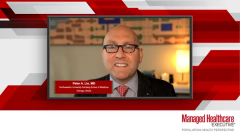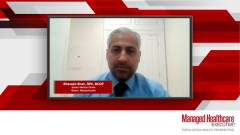
Barriers to Treatment Access in Atopic Dermatitis
Payer and clinician insight regarding access to effective therapies for atopic dermatitis and potential challenges adopting new therapies, including topical JAK inhibitors, into clinical practice.
Episodes in this series

Bhavesh Shah, RPh, BCOP: In regards to the question about the difficulties in managing this disease, I think a lot of it stems from patients not having access to appropriate providers who actually have expertise in this. Then, the second aspect is that in some of the economic analyses that were done, we did see that patients of African-American or minority descent actually had poorer outcomes and lower satisfaction compared to the predominantly white patient population with atopic dermatitis. It shows that there is a disparity in access to care, education, and the connection with the right providers. I think that really drives some of the other indirect costs that we’re seeing. I think we talked about what happens to a patient with ineffective therapies, or not having the appropriate diagnosis. And I think being a managed care Medicaid health plan we do see a lot of those disparities in these patients. So I think there’s definitely more that we can do, and it’s definitely challenging when you don’t have resources poured toward creating that open forum for patients to be able to access despite having all of these disparities.
I think the landscape is definitely changing rapidly for atopic dermatitis. And you’re absolutely right in terms of not having the appropriate expertise. If you look at when I am part of the direct care of patient responsibilities, many providers are actually very used to how they manage a disease. So when a new drug comes out, there’s always some skepticism about adopting new therapies right away, even if they may be highly effective. And then, of course, not having a specialist who’s prescribing this, who may be well versed in the new agents that are coming into the market, and how they should be utilized. But where does it really fit into the treatment for many of their patients? There was a survey done by Bryan Chang and his team—he was a senior author—that was presented at the atopic dermatitis virtual symposium recently, I believe. Essentially, they identified thousands of patients who had atopic dermatitis and they did a 5-question patient satisfaction survey, using the CAHPS [Consumer Assessment of Healthcare Providers and Systems] methodology, which hospitals use HCAHPS [Hospital Consumer Assessment of Healthcare Providers and Systems], so it’s actually measuring the providers. Did your provider explain to you the disease that you have in detail? Were you satisfied with the agent that they prescribed for you in your disease? Were they timely in providing you with information such as your labs and follow-ups and things like that? It was interesting because it was a 5-part, 5-question assessment, where many patients indicated they were not satisfied with their provider’s support. Essentially, there was also a finding that their disease wasn’t as controlled. So disease control was directly tied to patient satisfaction. So it’s really interesting when you can actually understand the dynamics of treatments and the treatment of the disease, where patients are probably not seeing the right providers and not getting the appropriate treatment in a timely fashion. There are a lot of barriers, I think, in optimizing these treatments, because maybe lack of provider expertise and not understanding the pipeline agents.
Peter A. Lio, MD: There are a lot of barriers to access, and this includes everything from misinformation to disinformation. Sometimes people come in and say, “I heard topical steroids are super dangerous. I don’t want to even touch them.” That’s an important thing. It’s difficult to convince somebody to change his or her mind in 15 minutes. Talk to anybody who’s discussing vaccination status or political things. We’re in a time now where people have very strong opinions and are very confident about them. Sometimes I find that it’s easier just to work with people at that moment rather than try to push back all the time. We have to sometimes take what we got and work overtime to establish a rapport and relationship. Education is part of the barrier but the other part, of course, is accessing them in terms of costs.There is a very confusing thing in American medicine. Sometimes the super expensive branded prescription will be much more accessible for the patient than what would appear to be the far cheaper generic. And it can have to do with things like a manufacturer’s coupon or a program where the company says, “You know what? We’ll take care of it for a year.” And that is confusing and difficult. There’s a lot of push back on us saying, “Hey, stewardship, we have to save the system money.” When you really pick that apart, yes, I’m trying not to bankrupt our healthcare system, but as we’ve already said, it is a for-profit healthcare system. And most of the people I’m dealing with are private insurance companies. On the other hand, I also have to take care of my patient. That’s my first concern. I can’t change that unwaveringly. The first real piece that I have to focus on is the patient. So if they can’t afford the medicine, well, what are we doing here? Then I’m completely powerless. I am more than happy to utilize programs from companies that are going to help make it more accessible. And sometimes it’s a better product to boot. It’s really hard. You’re making a sacrifice sometimes to pick a generic medicine, which you know less about. Sometimes it’s a different formulation. They are often the cheapest ingredients and I’m happy to do it. But when the price of the patient is $300, you’re saying, wait a minute, you can get the branded one that we know is nice. You can get that for $10. This is silly. These are some of the things that we face. Another issue is time. Patients have to do a lot in dermatology. If it’s just a pill, even that’s hard to get people sometimes to take, but when it’s a topical routine, it does take a lot of time and energy. So that could be another barrier to care. And we often just say, just put this cream on, but it’s not that easy. That is another aspect that we really have to consider for our patients and their families
Bhavesh Shah, RPh, BCOP: I think one of the biggest challenges that patients will face is going to be the cost-sharing involved with many of these agents. And as a payer, we have to basically use the dictated formulary that is chosen by the employer groups. Essentially, I think there’s going to be higher scrutiny for the oral agents, but less scrutiny for the topical JAK [Janus kinase] inhibitor. And I think Medicare patients will definitely be impacted more just because it is hitting part D for many of these patients.I think with oral agents there are always adherence issues. I think that’s one of the drug interactions and the system toxicities. And patients, in this specific disease, are not used to having drugs like a JAK inhibitor. I think just knowing some of the side effects, or listening to the side effects, patients may actually abandon therapy. I definitely think that there’s a lot that will need to be done in making sure patients stay on therapy. But in terms of formulary positioning, I think that’s going to be really driven by a lot of the cost factors, and even if there are opportunities for value-based contracting, or risk-based contracting, that may actually—can actually put these agents more frontline. I think there are definitely differences in how that will play out once they’re approved. Some are already being approved so I think we have some visibility on the cost. I think the cost will be one of the biggest factors where there will be a placed formulary in tiers in terms of the pathway and going from topical to oral.
Transcript edited for clarity.
Newsletter
Get the latest industry news, event updates, and more from Managed healthcare Executive.




















































